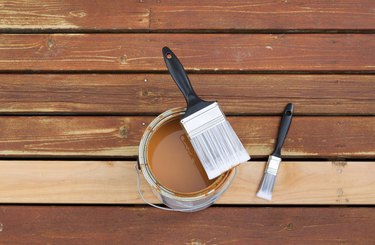
Cedar offers a durable option for exterior and interior building projects with natural resistance to rot and decay, so a protective finish is optional. If you want to enjoy the aroma of varieties such as Western red cedar and incense cedar, leave the wood unsealed. If you're using cedar for an outdoor project, however, give it a light seal coat to guard against moisture and sunlight.
The Benefits of Cedar
Cedar is naturally resistant to rot, but that isn't its only benefit as a building material. It's lightweight yet harder than most other softwoods, including fir and pine. It's structurally more stable than most wood species, which means that cedar is less likely to crack and split. Cedar's rot-resistant oils are highly aromatic, which makes cedar an effective insect repellant. One common species, Western red cedar, has such a high thermal coefficient that structures made from it remain cool on hot days.
Video of the Day
How To Seal Exterior Cedar
Because of its rot-resistance and stability, cedar used for outdoor projects, such as furniture, fences, siding, and play structures, lasts for years without any finish. But in direct sunlight, cedar retains its natural color for only a few months. You can prevent it from turning gray by finishing it with a material that reflects the ultraviolet sunlight that breaks down the surface fibers.
Video of the Day
An effective option is a semitransparent stain containing cedar-colored pigments. You can refresh it as needed to maintain the natural colors. If weather-resistance is your main concern and you aren't concerned about color, use a water-sealing finish. Most of these products contain paraffin that forms a light coating inside the grain and sheds water.
Here's how to seal exterior cedar:
- Apply the sealant or stain to clean, dry cedar. If the wood is wet when you apply the coating, it may not work well. Likewise, dirt or grime on the wood surface makes it impossible to get a good finish.
- Wash the wood first. Hand washing is better than using a power washer, which can cause damage. Let it dry completely before you start.
- You can apply your sealant with a brush or roller. Smaller areas call for a brush, so you can get into all the grooves to get an even coat. Pay special attention to joints, edges, and board ends as those areas are especially vulnerable to moisture. These coatings usually need to be repeated every one to two years.
How to Seal Interior Cedar
When retaining cedar's aromatic qualities isn't a priority in interior woodwork, a seal coat makes the wood easier to clean. When a hard glossy surface is desired on a tabletop or window ledge, a seal coat of thinned varnish or lacquer sanding sealer makes cedar easier to smooth in preparation for one or two top coats of varnish or lacquer. Cedar accepts most finishes well, including penetrating oils, such as tung oil and linseed oil. Penetrating oils are especially effective for sealing the grain while leaving the wood looking raw and natural.
Just like exterior applications, your interior sealing projects should start with clean cedar. Open a window or door in the room to help ventilate the area. Brush or roll the chosen sealant onto the interior cedar piece. Let the coating dry completely before you apply another coat.
Sealing Cedar for Painting
Cedar accepts paint, but more than any other wood except pine, it needs a coat of primer before you paint it. The natural oils in cedar can bleed through latex and oil paints and produce dark areas around knots and oil-rich sap lines. To prevent this, use a high-solid primer before you paint it. An alkyd oil-based primer offers strong protection against discoloration. Priming with a product that has a high percentage of pigment not only prevents bleed-through, it increases the coverage of the top coat and decreases the time it takes to apply it.
Primer can go onto the cedar via brush or roller. Like other coatings, it's important to start with a clean surface. If the cedar was previously painted, make sure any loose or peeling paint gets removed before priming. Cover the cedar completely with the primer before applying your paint.